

F2A - Brewster Buffalo
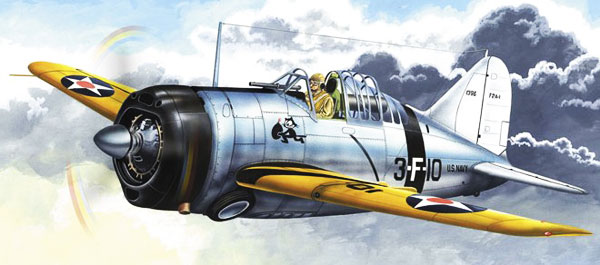
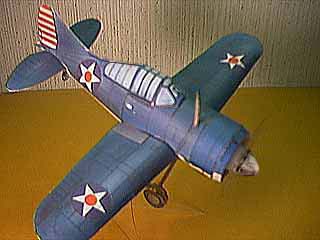
In 1935 U.S. Navy laid down specifications for a replacement for the Grumman F3F biplane equipping its four carriers. Brewster Aeronautical Corporation developed a design for a modern monoplane fighter with an enclosed cabin and retractable landing gear. The first flight of the XF2A-1 prototype was on 2 December 1937. The Navy accepted the XF2A-1 during June of 1938 and ordered series production of the F2A-1 for its carriers.
The portly Buffalo has gained a reputation as the worst fighter of World War II. In service it was overweight and lightly armed, and often outmaneuvered, but in the right hands could be quite effective. US Marine Buffaloes played a brief part in the Battle of Midway.
RAF and Commonwealth Buffalo pilots scored quite well against the Japanese Nakajima fighters encountered over Singapore, but were greatly outnumbered. Poor organization and no early-warning system saw that the Buffaloes were never airborne before the enemy appeared and were always at a lower height when combat was joined. The Buffalo squadrons were cleared from the skies in short order. The Finns, using the lighter-weight F2A-1 and better tactics had great success against the early Soviet fighters they faced in their Continuation War with the USSR.
Finland's top-scoring fighter ace, Ilmari Juutilainen, scored 36 victories while flying the Buffalo in the 'Continuation War'. He converted to the Buffalo in 1940 and flew it until 1943, when his squadron re-equipped with the Messerschmitt 109G. His eventual score rose to 94. The astonishing thing about Juutilainen's combat career was that never once was his aircraft hit by enemy fire.
Downloaded your model and built up another 1/144 recycled styrene model (ruler in inches). It was a fun project, but was only finished this week after getting printed in December 2000 - not difficult, just too many other things to do.
Added details like a 3D 9-cylinder engine and landing gear, exhaust pipes, pilot tube, gun sight, radio mast, transparent canopies and spinning prop! Thanks for an excellent design - it really looks like a US Buffalo, even with minor quibbles about the cowl. Lorenzo S. F. de la Fuente (11/01)
After going on Google and finding a free F2A buffalo, my favorite WWII plane, I built it from the sheet on the International Buffalo site. I used a P-40 cockpit interior and seat from another site. I made a radio aerial from a tooth pick and a sight and exhaust from your thumbnail Ju-88 bombs. I had the cockpit open and it was the best model I have ever made. Unfortunately, it was lost when my house flooded, but I will rebuild it. Mark (5/06)
I was looking at the Brewster Buffalo in the WW2 section and noticed you have a link talking about the Buffalo serving in the Finnish air force. My family happens to be from Finland. I was curious if you guys would ever do a repaint of the Buffalo in Finnish camo and markings. Finland also happened to use the Me-109 that they purchased from Germany in 1941/42 , even though it was the later "G" model they used it would still be very neat to see you do a repaint of the 109 as well. Just thought it might make for some interesting varieties. Allen
P.S I've already bought the "Light Aircraft" and the "Racers" CD's and would have had them put together but my darn printer has been on the blitz for awhile. Considering these models are made from paper the detail is amazing. Thanx for giving us pilots something to do on the days we cant be flying the real stuff. :-) 7/06
I have a F2A Brewster Buffalo in regular size repainted and redrawn as an Aussie Commonwealth Boomerang Mk1. It's my second attempt at it; I've also created some extra detail bits to add on to the model, unfortunately I have no picture of it complete as I've got one of my wrists in a bandage* and a printer that's forgotten what color black is. If I got my facts and insignia right, then this model is of a f2a that brought down two Japanese boomers,” Lizzys “I think. (see thumbnail above)
So here is a historically fairly accurate repaint of the F2a Brewster Buffalo in Commonwealth colors and insignia, as flown by the Australians and New Zealanders in defense of Singapore. Please use the attached PDF to replace the old F2a Boomarang PDF. Peter Spiess, Australia
The F2A Brewster Buffalo, WWII US Fighter by Fiddlers Green
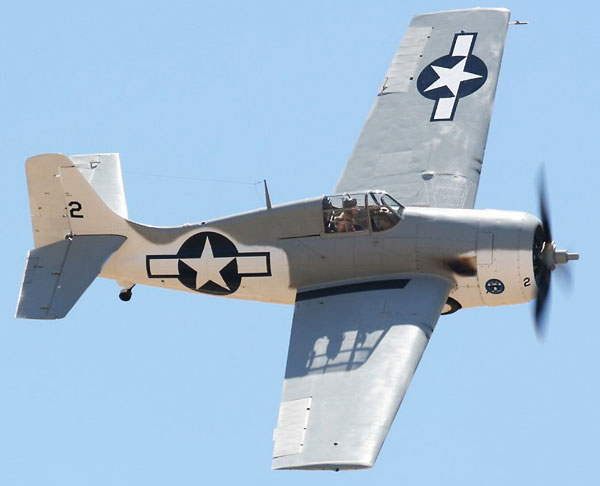
Grumman F4F Wildcat...sometimes mistaken for a F2A Brewster Buffalo!
A US Navy contract placed with the Brewster Aeronautical Corporation on June 22, 1936, initiated construction of the prototype of what was to become the first monoplane fighter equipping a Navy squadron. The Model 39 fighter, designated XF2A-l by the Navy, bore a distinct family resemblance to the XSBA-l. The design was characterized by the short, stubby fuselage, stalky inward-retracting main gear with wheel wells in the belly, and mid-mounted wing of low aspect ratio. The power plant around which the original design was planned was the 950 hp Wright XR-1820-22, and the armament comprised two 050-in guns in the engine cowling plus two wing guns added later.
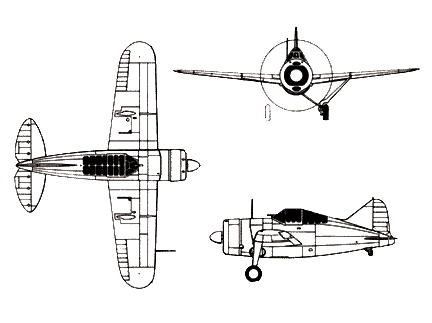
First flight of the XF2A-l was made in December 1937, and it was delivered for Navy testing a year later. Meanwhile, the first production contract had been placed on June II, 1938, for 54 F2A-ls, and the first of these aircraft was rolled out in June 1939. They were powered by the 940 hp R-1820-34 engine and had a larger fin. In the course of the following year, II F2A-ls reached the Navy, and 10 of these were in service with Fighting Squadron VF-3 aboard the USS Saratoga by June 1940. The remaining aircraft on the original contract were released by the United States for sale to Finland early in 1940, to be replaced by 43 F2A-2s.
The F2A-2 had originated on March 22, 1939, when the USN ordered conversion of the prototype to XF2A-2 with a 1,200 hp R-1820-40 engine and redesigned rudder. Other changes were from hydraulic to electric propeller, and addition of a high-altitude carburetor system. Testing of the XF2A-2 began in July 1939, and production deliveries started in September 1940.
Finally, the Navy ordered 108 F2A-3s on January 21, 1941, and took delivery of these between July and December the same year. Features of this model were increased armour protection for the pilot and for the fuel tank, and improved equipment, the weight of which adversely affected the aircraft's performance. Navy Squadron VF-2 operated F2A-3s aboard the USS Lexington, and VS-201 took a small number aboard the escort carrier Long Island; one Marine squadron, VMF-221, also flew F2A-3s (and F2A-2s). The fighter achieved little operational success, its only major battle being that at Midway when the Marine squadron suffered major losses.
The demise of the biplane fighter for carrier duty was heralded by the arrival of Brewster's F2A Buffalo. Brewster had been assigned the manufacturer's code letter "A" after the General (Atlantic) Company had been dissolved. Since there had already been an FA-1 on the Navy's roster, Brewster's first offering became the F2A.
The Brewster Company was new to the airframe business. Its only previous experience was in the construction of seaplane floats for the Navy. In 1932, the Brewster Aeronautical Corporation was formed with the ultimate intention being the design and construction of military aircraft. Their first product was an experimental monoplane scout bomber, the XSBA-1, flown in 1936. Brewster was underbid for the production contract of their scout bomber, but on the basis of the design, they received a development contract for the monoplane fighter.
It may seem strange that a relatively new company was selected to develop such an important subject as the Navy's first monoplane fighter; but Brewster's engineering methods reflected contemporary ideas, and the XF2A.1 was as modern as current technology permitted. The prototype XF2A-was ordered on June 23, 1936, after the drawings had been reviewed. It was to use a Wright R- 1820-22 engine; have hydraulically retractable landing gear; and be of all-metal stressed skin, flush-riveted construction. One of the constant complaints regarding the monoplane configuration was poor pilot visibility. To overcome this, Brewster engineers provided a clear panel in the underside> of the fuselage of the XE2A.1; but this was deleted on the -2 and later subtypes.
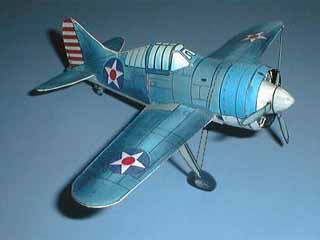 The first flight of the Buffalo, as it became known, was undertaken
in December 1937; however, its original performance did little
to encourage the Navy which was counting so heavily on it as a
biplane replacement. At 15,200 feet, the XF2A-l could only reach
a speed of 277.5 mph, or 13 mph faster than the F3F. 3-hardly
an improvement to get excited about.
The first flight of the Buffalo, as it became known, was undertaken
in December 1937; however, its original performance did little
to encourage the Navy which was counting so heavily on it as a
biplane replacement. At 15,200 feet, the XF2A-l could only reach
a speed of 277.5 mph, or 13 mph faster than the F3F. 3-hardly
an improvement to get excited about.
The Langley wind tunnel was utilized and the prototype XF2A-l was subjected to a series of airflow tests. This was the first time in the United States that a full-size airplane was wind-tunnel tested. Guided by the test results, several minor refinements were made to the Buffalo, and when flying was resumed, a phenomenal speed of 304 mph was reached at 17,000 feet.
The future of the Brewster fighter looked good now, and simulated carrier landings were undertaken. The Buffalo had hydraulically .operated split flaps to help slow it to a speed of 67 mph for carrier approach, but during one hard landing the prototype was severely damaged.
By this time, the advanced performance was evident and Brewster received a production order for 54 F2A-1's. So the Buffalo was assured its place in history as the Navy's first operational monoplane fighter. (The Buffalo was actually the second production carrier-based monoplane-it was preceded by the Douglas TBD. 1 Devastator torpedo bomber.)
Setting up the production line for their fighter created many problems for the Brewster Company, severely hindering its delivery schedule. The first F2A- I was finished in July 1939, but they were unable to complete enough planes to outfit a squadron until the following December. On the 8th day of that month, VF-3 received the first ten of the new Buffalos, Before any further F2A-1's were delivered, however, the Navy ordered Brewster to upgrade the remaining Buffalos to the F2A-2 standard based on trials of the rebuilt XP2A.
Following its accident during carrier trials, the XF2A.1 had been returned to Brewster where the damage was repaired and a 1,200 hp R-1820-40 Wright engine installed. In addition, the canopy had been raised and a larger vertical stabilizer added. While the F2A.2 production was getting underway, the remaining 43 F2A-1's were completed as Brewster Model B-239's and sold to Finland. This group of Buffalos was to prove the most successful of the type, as the stubby fighter was ideally suited to the conditions under which they were operated in Europe.
Meanwhile, reports from VF.3 on board the 1355 Saratoga were
revealing serious problems with the F2A-1's. Foremost of these
was landing gear failure. The Vee structure of the gear struts
was inherently weak and the stresses of an arrested landing were
more than they could withstand. This defect remained with the
Buffalo throughout its life. By now, it was too late to have second
thoughts about the F2A as the Navy needed fighters. The new Grumman
F4F's could not be produced fast enough to fill this need, so
Brewster received another contract for the Buffalo-this time for
108 improved F2A-3 types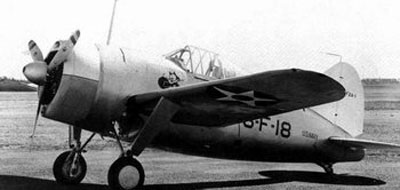 .
.
The F2A-3 was similar to the -2, but the engine was moved forward for greater CG limits. The space behind the engine was used for additional fuel and the capacity was increased by 76 gallons.
Brewster was ready to deliver the F2A-3's in July 1941; and by December, three squadrons were using the new Buffalo. Even on the F2A.3, the landing gear collapsed; and now a new problem arose-arresting hook failures which were ultimately traced to deliberate sabotage during assembly.
When the Japanese attacked Pearl Harbor on December 7, 1941, both the Navy and Marines were flying the Brewster fighter. During that month, pilots flying the export model of the Buffalo had learned of the fighter's combat shortcomings; but it wasn't until the Battle of Midway, on June 4, 1942, that American pilots would become aware of them.
It would be unfair to criticize the Navy for the failures manifested by its first monoplane fighter by saying they waited too long before accepting the demise of the biplane. The Buffalo's main opponent was the vastly superior Zero-Sen, and even the more advanced Air Corps types were overwhelmed by this nimble warrior. In addition, the Japanese pilots had been trained with the intent of engaging in warfare. The very existence of the Zero-Sen had come as a startling surprise to the Allies, and here was a plane destined to rank among the world's greatest.
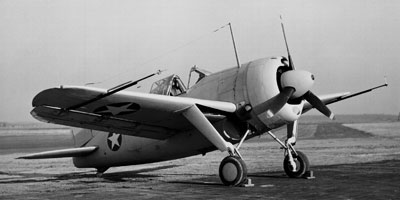
Under different Circumstances, where the Buffalo was not overwhelmed by sheer numbers, it proved to be an effective machine. In Finland it was a popular weapon against the Russian invaders, where it was operated for three years before being replaced with Messerschmitt Bf 109's.
When production of the Buffalo had been concluded, 162 had been delivered to the Navy. An additional 346 export models had also been constructed. Just one of these planes survives today, an historic exhibit in a Finnish museum.
Throughout the modifications made to the Buffalo, the wing remained the same with a 35 foot span and an area of 209 square feet. The F2A-1 was 26 feet long, 11 feet 8 inches high, and weighed 3,785 pounds empty, 5,055 pounds gross. Fuel capacity was 160 gallons. Top speed was 301 mph at 17,000 feet.
The F2A-2 was 25 feet 7 inches long, stood 12 feet high, had an empty weight of 4,576 pounds, grossed at 5,942 pounds, and carried 242 gallons of fuel. Maximum speed for this model was 323 mph at 16,500 feet, making it the fastest of the type.
The length of the F2A-3 was 26 feet 4 inches. It also was 12 feet high. Weight was 4,732 pounds empty, 6,321 pounds loaded, and could reach 321 mph at 16,500 feet.
Initially, the F2A carried the prescribed pair of .30 cal. and .50 cal. machine guns in the nose, but allowance had been made to install a pair of .50's in the wing outside the propeller arc. For combat, all four positions were occupied by .50 cal, weapons. In addition, one 116 pound bomb could be mounted under each wing.
One further attempt was made to improve the Buffalo's capabilities. The first F2A.3 was fitted with a pressured cabin as the XF2A.4, but evaluation of this system led to rejection and no further development of the series was undertaken.
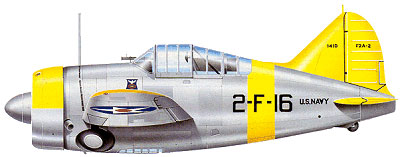
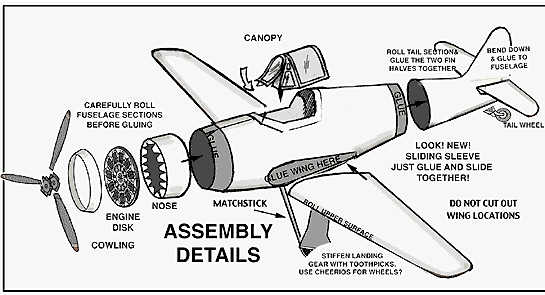
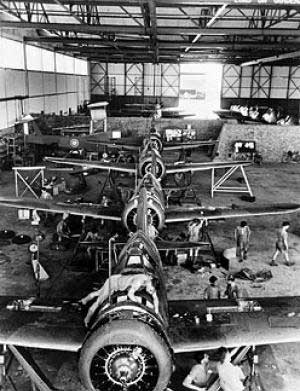 |
Brewster Buffalo Repairs. |
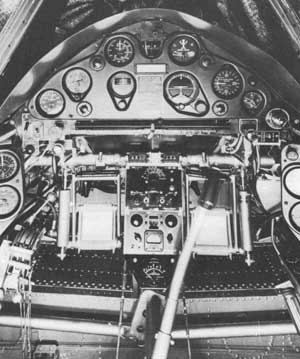 |
Brewster F2A Buffalo Cockpit. |
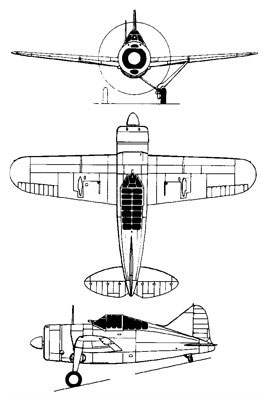 |
Length: 26 ft 4 in Wingspan: 35 ft Height: 12 ft 1 in Wing area: 208.9 ft² Empty weight: 4,732 lb Max takeoff weight: 6,321 lb Performance Maximum speed: 284 mph at sea level, 321 mph at 16,500 ft Cruise speed: 171 mph Range: 1,680 mi Service ceiling: 30,000 ft Rate of climb: 2,440 ft/min Armament 2 × 0.50 in (12.7 mm) nose-mounted M2 machine guns 2 × 0.50 in (12.7 mm) wing-mounted M2 machine guns 2 × 100 lb (45 kg) underwing bombs |
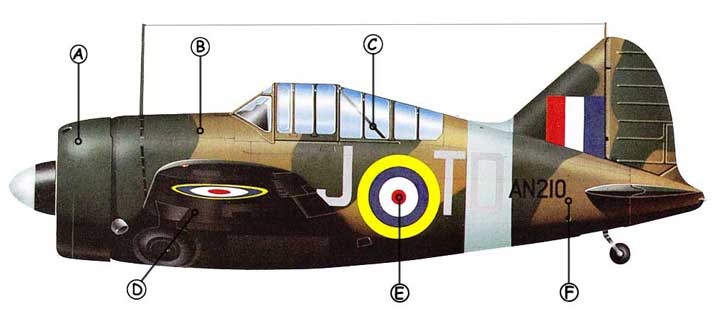 |
||
| A: The Wright R-1820 Cyclone engine powered the Buffalo to max speed of 292 mph. Being the US Navy's first monoplane fighter gave it notoriety with foreign air forces. | B: Addition of armor plate on the F2A-2 version reduced any performance advantage the basic Buffalo may have had over Japanese fighters. | C: The Buffalo gained something of a reputation among air forces. A good aeroplane, but not for fighting was one British pilot's view, but the many Finnish aces would disagree. |
| D: The F2A-1 was only armed with two machine guns, one 7.62mn (0.3in) and one 12.7mm (0.5in). Most export models also had wing guns, but RAF examples often flew with half ammunition to save weight. | E: The Finns liked the Buffalo enough to design a version called the Humu ('Reckless') with a wooden wing and a Russian engine. It proved unsatisfactory in trials and only a sing example was built. | F: The Finnish Buffaloes were delivered too late to see combat in the 'Winter War' of 1939-40, but acquitted themselves well in later conflict against the Russians. |
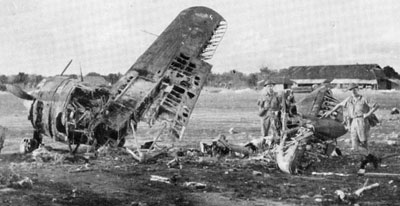 |
| A Brewster Buffalo fighter destroyed on the ground during one of the heaviest raids on Kallang airfield |


